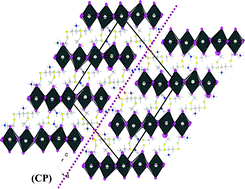PbnI4n+2(2n+2)− (n = 3, 5) ribbons, which can be regarded as dimensional reductions of 2D perovskite layers, are stabilized by diprotonated cystamine cations in (NH3(CH2)2SS(CH2)2NH3)4Pb3I14,I2 (1) and (NH3(CH2)2SS(CH2)2NH3)6Pb5I22·4H2O (2). Both 1 and 2 have interesting structural characteristics; it is unprecedented that the ribbons are linked via I2 molecules incorporated in the lattice of 1, while tetrameric water clusters are trapped in the structure of 2. 2 undergoes a (reversible) water desorption process at 310 K leading to (NH3(CH2)2SS(CH2)2NH3)6Pb5I22·2H2O (3). The electrical behavior of 2 and 3 has been investigated in the ranges 293–310 K and 310–358 K respectively. Above 310 K, the electronic contribution remains constant while the ionic transference number tends towards unity showing almost pure ionic transport at 360 K (6 × 10−7 S cm−1 at 330 K) originating probably from the migration of protons through the hydrogen bonds connecting the water molecules to the cystamine counter cations.

You have access to this article
 Please wait while we load your content...
Something went wrong. Try again?
Please wait while we load your content...
Something went wrong. Try again?


 Please wait while we load your content...
Please wait while we load your content...